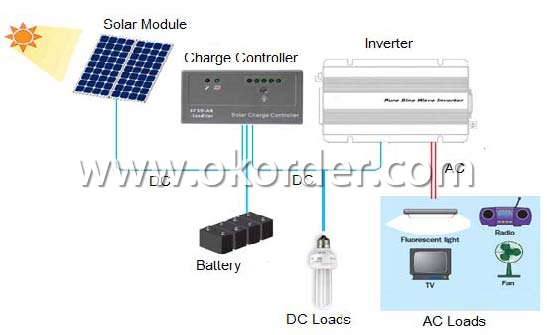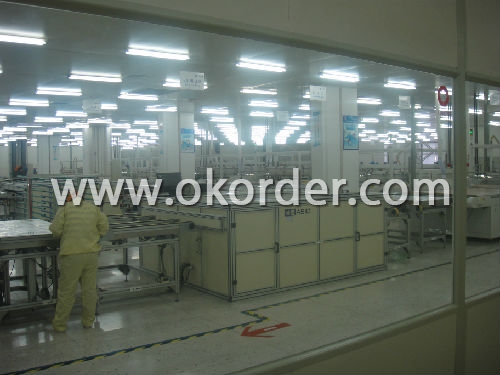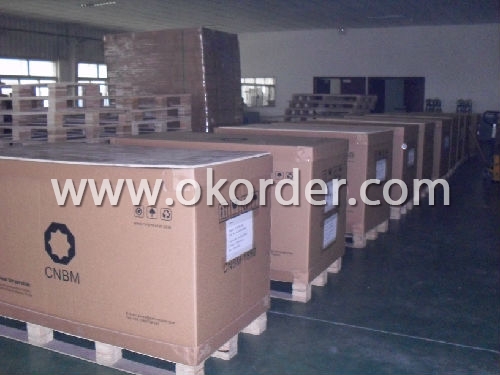Solar Home System CNBM-K2 (80W)
- Loading Port:
- China Main Port
- Payment Terms:
- TT
- Min Order Qty:
- 1 set set
- Supply Capability:
- 1000 sets per month set/month
OKorder Service Pledge
OKorder Financial Service
You Might Also Like
Brief Introduction of Solar Home System CNBM-K2 (80W)
CNBM Home System-K2 (80W) has a wonderful capacity.It can be used in factory,home,school and other CNBM Home System-K2 (80W) consist of the solar modules,charge controller,inverter and battery banks.
CNBM International is highly recognized by its business partners and clients all over the world and has obtained rapid development under the spirit of win-win .
With CNBM Home SystemK2 (80W),We will carry on the mutual beneficial,innovative and revolutionary trading structure as we did before,create value for our employees,share holders and clients and benefit the whole society in our future development.Please contact us ,if you have interest in CNBM Home System-K2 (80W),don’t hesitate!
The Sketching of Solar Home System CNBM-K2 (80W)

Components of Solar Home System CNBM-K2 (80W)
PV Array:
Convert sunlight instantly into DC electric power. Formed by the solar modules (also called photovoltaic modules) in accordance with the system requirements for series and parallel.
Solar Charge Controller:
A charge controller may be used to power DC equipment with solar panels. The charge controller provides a regulated DC output and stores excess energy in a battery as well as monitoring the battery voltage to prevent over charge or over discharge. An inverter can be connected to the output of a charge controller to drive AC loads.
Inverter:
Converts DC output power of photovaltaic soalr panels into standard AC power for use in the local off-grid electrical network. It is a critical component in a photovoltaic system, allowing the use of ordinary commercial appliances.
Battery banks:
Stores energy when there is an excess coming in and distribute it back out when there is a demand. Solar PV panels continue to re-charge batteries each day to maintain battery charge.
Technical data of Solar Home System CNBM-K2 (500W) | ||
Inverter | Rated load power | 500W |
Output wave | Modify sine wave | |
Output voltage | DC 12V | |
Output frequency | DC:12V AC:220V | |
Precision of output | 50HZ/60HZ | |
Precision of output frequency | ±6% | |
Solar panel | Pmax | 80W |
Vmp | 17.8V | |
Imp | 4.49A | |
Charger | Charger voltage & current | 12V 10A |
Battery | Capacity | 12V 40AH |
Power box | Spray paint iron box,with input,output,ammeter,voltmeter,master swith and so on. | |
Package of Solar Home System CNBM-K1 (60W) | ||||
Part | Size(L*W*H mm) | Weight(kg) | 20’(pcs) | 40’(pcs) |
Power box | 580*280*540 | 50 | 120 Sets | 280 Sets |
Solar panel | 890*670*30 | 8 | ||
Battery | 200*180*170 | 15 | ||
Factory Picture of Solar Home System CNBM-K2 (80W)

Package Picture of Solar Energy System CNBM-K2 (80W)

- Q:Can solar energy systems be used in commercial or industrial applications?
- Yes, solar energy systems can definitely be used in commercial or industrial applications. In fact, many businesses and industries are increasingly adopting solar energy as a cost-effective and sustainable solution to meet their energy needs. Solar panels can be installed on rooftops or open land to generate electricity, which can be used to power various operations, including manufacturing processes, lighting, cooling, and heating systems. Additionally, solar thermal systems can be implemented for water heating or other industrial processes. The use of solar energy in commercial and industrial applications not only helps reduce carbon emissions but also offers long-term financial benefits by reducing dependence on traditional energy sources.
- Q:How does the cost of solar energy compare to other energy sources?
- The cost of solar energy has become increasingly competitive with other energy sources in recent years. Initially, the high installation costs and limited efficiency of solar panels made it more expensive compared to traditional energy sources such as fossil fuels. However, advancements in technology, economies of scale, and supportive government policies have significantly reduced the cost of solar energy. Today, the cost of solar energy is rapidly declining, making it one of the most affordable and competitive forms of energy. In many regions, solar power is already cheaper than coal and natural gas, which were traditionally the cheapest sources of energy. This trend is expected to continue as solar technology continues to improve and become more efficient. One of the main reasons for the cost reduction in solar energy is the decreasing prices of solar panels. Over the years, there has been a significant drop in the prices of photovoltaic (PV) modules, the key component in solar panels. Additionally, the manufacturing process has become more streamlined and efficient, leading to cost savings. Furthermore, the operational costs of solar energy are relatively low since sunlight, the primary fuel source, is abundant and free. Compared to fossil fuel-based power plants, solar energy systems require less maintenance and have a longer operational lifespan, resulting in lower operating costs over the long term. Government incentives and policies have also played a crucial role in reducing the cost of solar energy. Many countries and regions offer financial incentives, tax credits, grants, and subsidies to promote the adoption of solar energy. These initiatives make solar installations more affordable for consumers and encourage investment in solar technology, driving economies of scale and further reducing costs. In summary, the cost of solar energy has become highly competitive with other energy sources due to technological advancements, economies of scale, and supportive government policies. As solar energy continues to become more affordable, it is expected to play a significant role in the global energy transition, providing a clean, sustainable, and cost-effective alternative to traditional energy sources.
- Q:Can solar energy systems be used to charge electric vehicles?
- Absolutely, electric vehicles can certainly benefit from the utilization of solar energy systems. The process is quite straightforward: solar panels convert sunlight into electrical energy, which can then be employed to charge the batteries of electric vehicles. Consequently, these vehicles can operate on clean and renewable energy. Many individuals and businesses are opting to install solar panels on their rooftops or dedicated solar carports to harness solar power and directly charge their electric vehicles. This not only reduces their dependence on the grid but also contributes to the reduction of greenhouse gas emissions and the fight against climate change. Moreover, there are also portable solar chargers available that can be used to charge electric vehicles while on the move, making solar energy an increasingly popular and sustainable alternative for powering electric vehicles.
- Q:Can solar energy systems be installed in areas with high winds?
- Solar energy systems are indeed capable of being installed in areas that experience strong winds. The consideration of wind speeds during the installation of solar panels is vital to guarantee their durability and longevity. These panels are specifically engineered to endure various weather conditions, including gusty winds. By implementing robust mounting systems and utilizing suitable fasteners, their ability to resist wind damage can be further reinforced. Furthermore, certain manufacturers subject their solar panels to rigorous testing procedures to ensure they can withstand high wind speeds. It is highly advisable to seek the guidance of a professional installer who can evaluate the unique conditions of the location and develop a solar energy system that can effectively endure strong winds.
- Q:What is the lifespan of solar energy inverters?
- The lifespan of solar energy inverters can vary depending on several factors such as the quality of the inverter, its usage, and maintenance. Generally, a well-maintained and high-quality solar energy inverter can have a lifespan of around 10 to 15 years. However, with advancements in technology and improved durability, some inverters can last even longer, up to 20 years or more. It is important to note that regular maintenance, such as cleaning and inspecting the inverter, can help extend its lifespan. Additionally, choosing a reputable brand and ensuring proper installation can also contribute to a longer lifespan for solar energy inverters.
- Q:Can solar energy systems be used in areas with limited sunlight hours?
- Solar energy systems can indeed be utilized in regions with minimal sunlight hours. Although solar panels generate the highest amount of energy when directly exposed to sunlight, advancements in technology have made it feasible for solar systems to still produce electricity even in areas with limited sunlight. One method to tackle the issue of limited sunlight hours is by installing solar panels that are more efficient at capturing and converting sunlight into electricity. These high-efficiency solar panels can optimize energy production even in areas with reduced sunlight. Additionally, the utilization of tracking systems that tilt and follow the sun's path throughout the day can also aid in increasing energy output. Another approach involves storing excess energy generated during peak sunlight hours in batteries. This stored energy can then be utilized during periods of low sunlight, enabling the solar system to continue powering homes or businesses even in the absence of sunlight. Furthermore, integrating solar power with other renewable energy sources, such as wind or hydroelectric power, can help compensate for limited sunlight hours. By combining different sources, a more reliable and consistent energy supply can be achieved. In conclusion, although limited sunlight may impact the energy production of solar systems, there are numerous technological solutions and strategies that can be employed to make solar energy feasible even in areas with fewer sunlight hours.
- Q:Can solar energy systems be installed on commercial buildings?
- Yes, solar energy systems can be installed on commercial buildings. In fact, many businesses and organizations are increasingly adopting solar power as a sustainable and cost-effective alternative to traditional energy sources. Installing solar panels on commercial buildings can help reduce electricity costs, lower carbon emissions, and contribute to a greener future.
- Q:What are the benefits of using solar energy?
- There are several benefits of using solar energy. Firstly, it is a renewable source of energy, meaning it is abundant and will not deplete over time. Solar energy also helps reduce greenhouse gas emissions, as it does not produce any harmful pollutants during operation. Additionally, it can save money on electricity bills in the long run, as solar panels have a long lifespan and require minimal maintenance. Finally, solar energy provides energy independence, allowing individuals and communities to generate their own power and reduce reliance on traditional energy sources.
- Q:What are the components of the solar photovoltaic system?
- TPT: on the back of the solar battery cover of fluorine plastic film is white, the sun has reflection function, so the efficiency of components increased slightly, and because of its high infrared emissivity, can reduce the working temperature of the component, but also conducive to improve the efficiency of the component. Of course, the fluorine plastic film with the first solar cell packaging materials required for aging, corrosion resistance, air permeability and other basic requirements.
- Q:Can solar energy systems be used in powering construction sites or temporary structures?
- Yes, solar energy systems can definitely be used to power construction sites or temporary structures. In fact, solar power is increasingly being utilized in these scenarios due to its numerous advantages. Firstly, construction sites often lack access to traditional power sources, which makes solar energy a practical solution. Solar panels can be easily installed on rooftops, scaffolding, or even on the ground, providing a reliable source of electricity throughout the construction process. Secondly, solar energy systems offer flexibility in terms of power generation. They can be customized to meet specific energy demands of construction sites, whether it is for running power tools, lighting, or charging equipment. This adaptability ensures that construction activities can proceed smoothly without interruptions. Additionally, solar energy systems are environmentally friendly. By harnessing energy from the sun, construction sites can significantly reduce their carbon footprint and contribute to sustainable practices. Solar power does not produce harmful emissions or noise pollution, which is particularly beneficial in urban areas or sensitive environments. Furthermore, solar energy systems offer cost savings in the long run. While the initial investment for installing solar panels might be higher compared to traditional generators, the ongoing operational costs are significantly lower. Construction sites can benefit from reduced fuel expenses, maintenance costs, and reliance on fossil fuels. It is worth mentioning that solar energy systems can also be used for temporary structures such as mobile offices, portable restrooms, or event venues. These structures can be easily powered using solar panels, eliminating the need for generators or grid connections. In conclusion, solar energy systems are a viable and sustainable option for powering construction sites and temporary structures. They provide reliable, customizable, and cost-effective power solutions while minimizing environmental impact. As the global shift towards renewable energy continues, solar power will likely become even more prevalent in construction industry practices.
1. Manufacturer Overview |
|
|---|---|
| Location | Ningbo,China |
| Year Established | 2004 |
| Annual Output Value | Above US$0.3 Billion |
| Main Markets | Australia;Europe. |
| Company Certifications | ISO9001:2008;VDE;CE |
2. Manufacturer Certificates |
|
|---|---|
| a) Certification Name | |
| Range | |
| Reference | |
| Validity Period | |
3. Manufacturer Capability |
|
|---|---|
| a)Trade Capacity | |
| Nearest Port | Ningbo |
| Export Percentage | 0.4 |
| No.of Employees in Trade Department | 10 People |
| Language Spoken: | English;Chinese; |
| b)Factory Information | |
| Factory Size: | Above 4,000 square meters |
| No. of Production Lines | Above 5 |
| Contract Manufacturing | OEM Service Offered;Design Service Offered |
| Product Price Range | Average |
Send your message to us
Solar Home System CNBM-K2 (80W)
- Loading Port:
- China Main Port
- Payment Terms:
- TT
- Min Order Qty:
- 1 set set
- Supply Capability:
- 1000 sets per month set/month
OKorder Service Pledge
OKorder Financial Service
Similar products
New products
Hot products
Related keywords





























